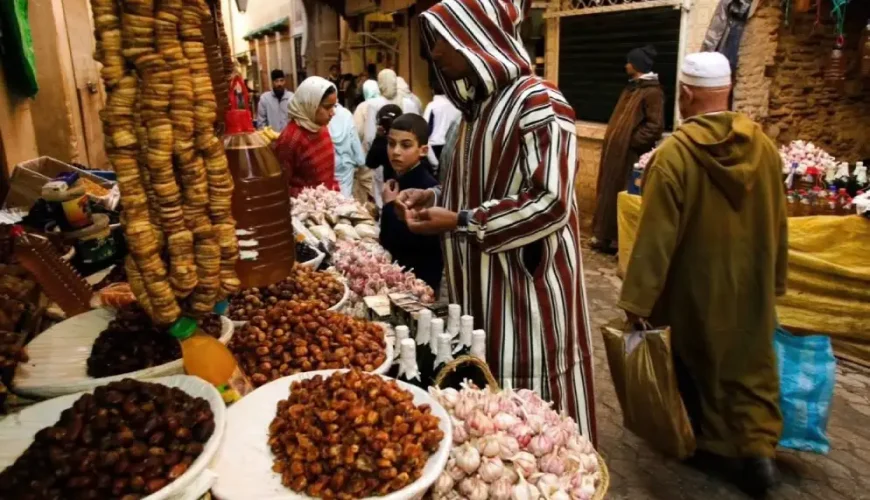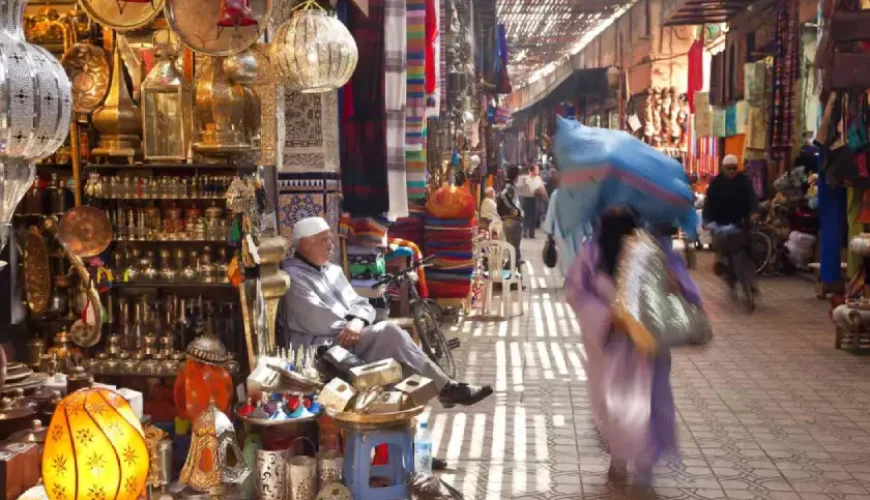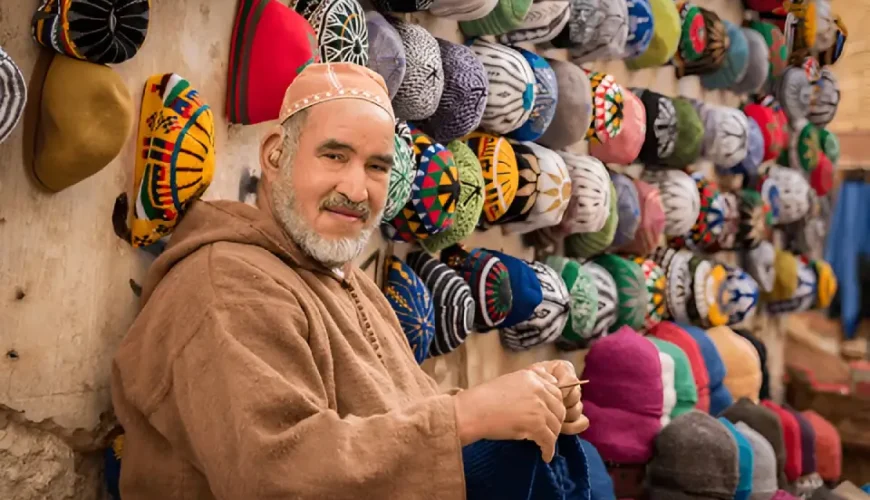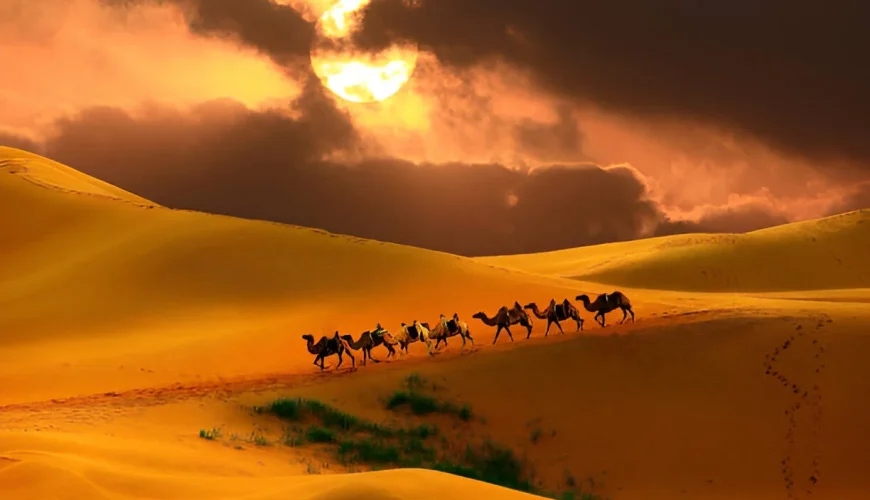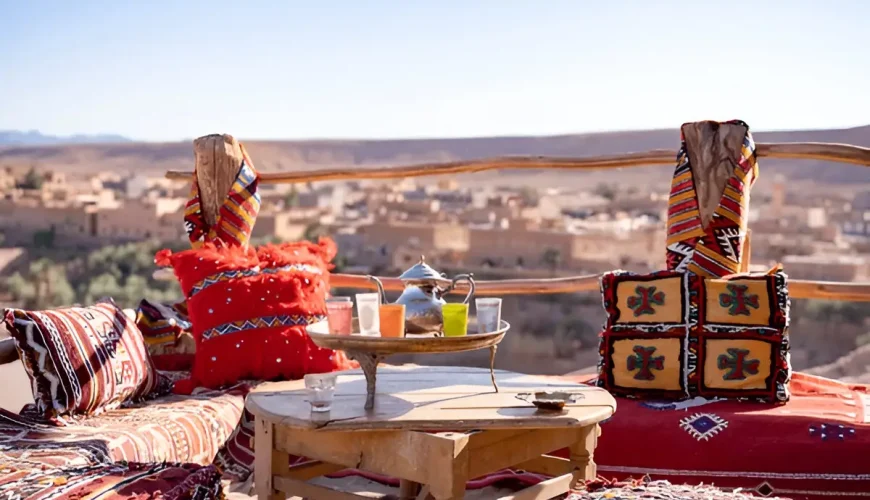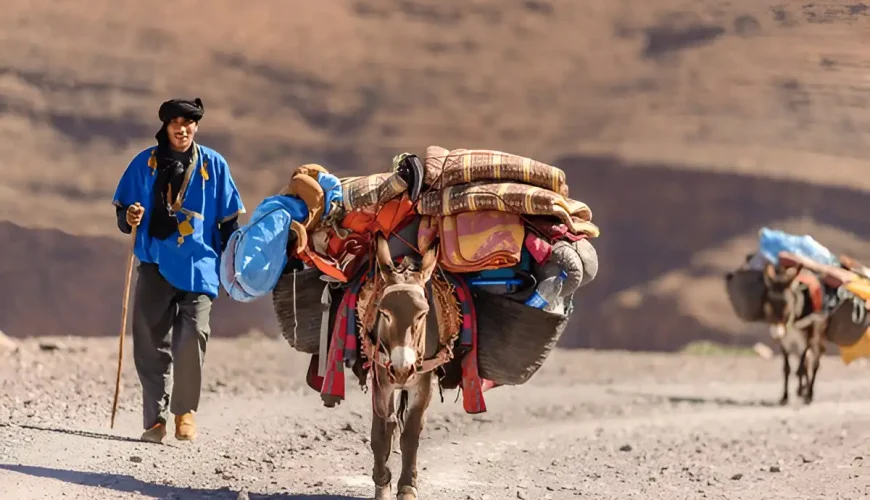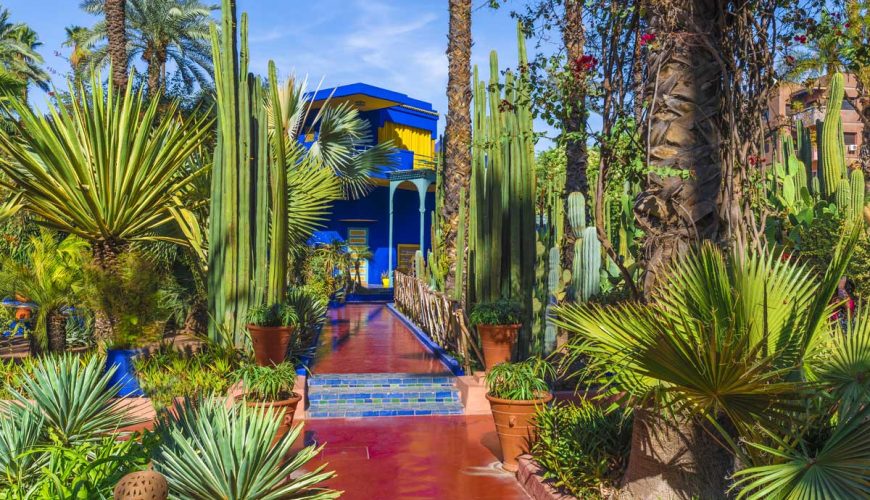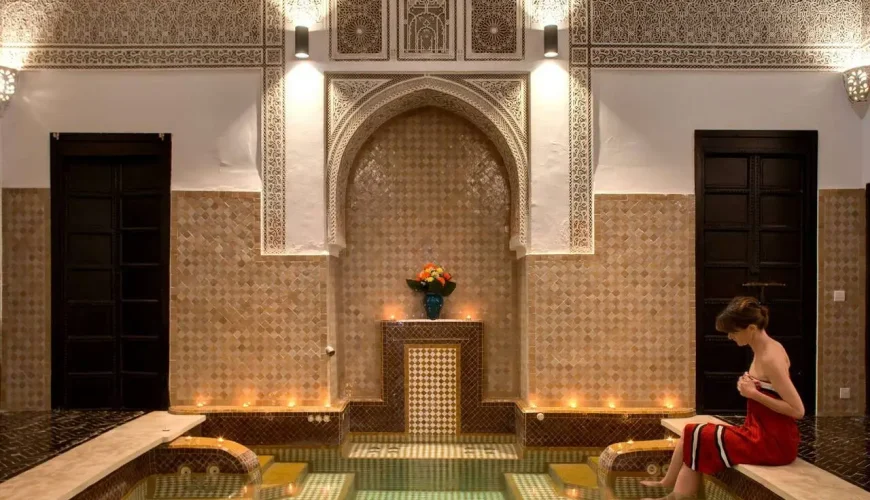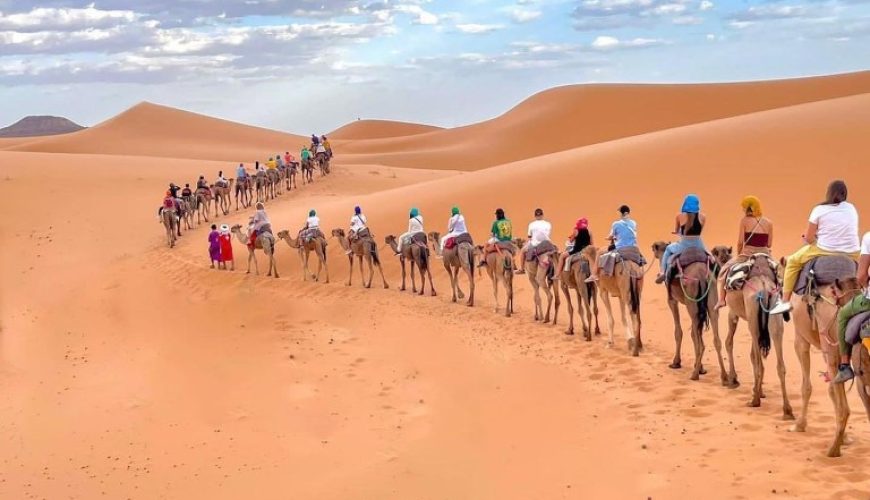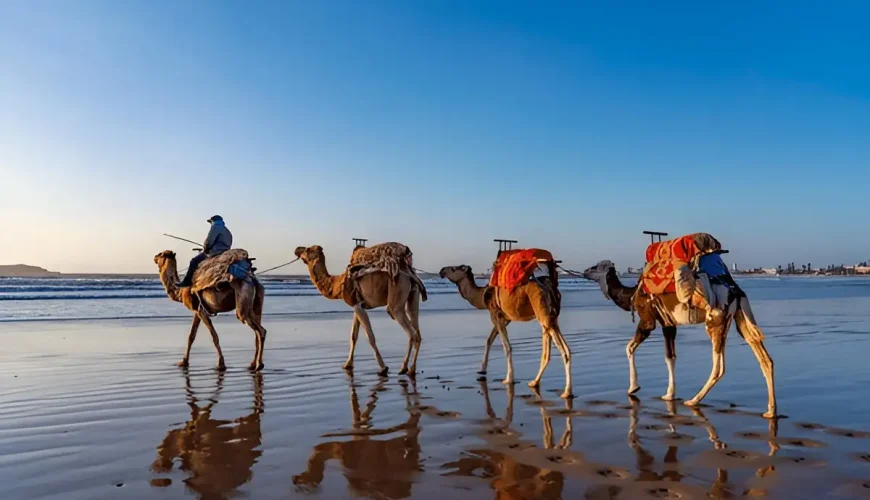Traveling to Morocco in December
Traveling to Morocco in December: Weather, Experiences, and What to Expect If you’re thinking about traveling to Morocco in December, you’re in for a unique and unforgettable experience. While much of Europe shivers through winter, Morocco offers a refreshing balance—warm days, cool evenings, and a vibrant cultural atmosphere that shines even brighter during the festive season. December in Morocco means fewer crowds, affordable luxury, and a chance to explore everything from snow-capped Atlas Mountains to sun-kissed dunes in the Sahara Desert. This guide dives deep into everything you need to know before traveling to Morocco in December—from weather insights and what to pack, to the best things to do and top tours to book. Whether you’re dreaming of camel rides under a glowing desert sunset, wandering through Marrakech’s lively souks, or cozying up in a riad courtyard with mint tea, December is one of the most rewarding times to discover the heart of Morocco. Customize your Tour to Morocco for December Is December a Good Time to Visit Morocco? Many travelers wonder, “Is December a good time to visit Morocco?” The short answer is—absolutely yes. December is one of the most comfortable months to explore the country, especially if you prefer mild temperatures and fewer tourists compared to spring and fall. 1. Ideal Weather for Exploration While northern countries face freezing temperatures, Morocco’s December climate is pleasantly moderate. Coastal cities like Casablanca and Essaouira enjoy average daytime highs around 20°C (68°F), making sightseeing a joy. Inland destinations such as Marrakech and Fes are slightly cooler in the mornings and evenings, hovering between 10°C and 22°C (50°F–72°F), while desert regions like Merzouga and Zagora are warmer during the day but can drop sharply at night. 2. Fewer Crowds, Better Prices Traveling to Morocco in December also means fewer crowds at major attractions like Jardin Majorelle in Marrakech or Volubilis near Meknes. Hotels and riads often offer off-season deals, allowing you to experience luxury accommodations for less. This is especially appealing for those who love peaceful travel and authentic encounters with locals. 3. Great Time for Desert Adventures If the Sahara is on your bucket list, December is one of the best months to visit. The days are warm but not scorching, and the crisp air gives the desert landscapes a surreal beauty. Camel treks, 4×4 rides, and overnight stays in luxury desert camps are far more comfortable compared to the heat of summer. In short, December is a fantastic time to visit Morocco—balancing comfortable weather, rich cultural experiences, and the perfect blend of serenity and celebration. Whether you’re planning a 10-day adventure through imperial cities or a 15-day grand tour that includes Essaouira and the Atlas Mountains, December offers the ideal conditions for exploration. Morocco Weather in December One of the biggest advantages of traveling to Morocco in December is the comfortable, travel-friendly climate that allows you to explore the country from coast to desert without the extreme heat of summer. December weather varies across regions, making Morocco a country where you can experience multiple seasons in a single trip—from crisp mountain air to warm desert sunshine. 1. Coastal Cities: Mild and Refreshing Cities along the Atlantic Ocean, such as Casablanca, Essaouira, and Agadir, enjoy mild temperatures averaging between 15°C and 24°C (59°F–75°F). The days are sunny, perfect for leisurely strolls along the beach or exploring coastal medinas, while evenings bring a cool ocean breeze. Rain is occasional but usually light—ideal for travelers who prefer pleasant, spring-like conditions in winter. 2. Marrakech and Fes: Warm Days, Cool Nights Inland destinations like Marrakech and Fes tend to be slightly warmer during the day but cooler once the sun sets. Expect temperatures around 10°C–22°C (50°F–72°F). It’s the perfect balance for sightseeing, as you can comfortably wander through the bustling souks and palaces without overheating. Just remember to pack a light jacket for evenings and early mornings, as temperatures can dip quickly. 3. The Atlas Mountains: Winter Wonderland December brings a completely different experience to the Atlas Mountains, where temperatures can drop to 0°C (32°F) or below at higher altitudes. You may even see snow dusting the peaks—a spectacular sight for travelers who want to mix adventure with scenic winter views. If you’re booking a 10-day or longer Morocco tour, you’ll likely pass through the mountains and can even enjoy traditional Berber hospitality in a cozy mountain village. 4. The Sahara Desert: Warm by Day, Cold by Night If you’re dreaming of desert adventures, traveling to Morocco in December offers the most comfortable desert weather. During the day, temperatures hover around 20°C (68°F), ideal for camel treks, sandboarding, and photography. However, as night falls, the mercury can drop to 5°C (41°F) or lower. That’s why luxury desert camps provide thick blankets, heaters, and warm tea around the campfire to ensure cozy nights under the stars. In short, Morocco weather in December is diverse and delightful—warm enough for adventure, cool enough for comfort, and perfect for exploring the full range of Morocco’s landscapes in a single trip. Some best Tours for December 15 Days Tour from Casablanca 5 (30 Reviews) Form $1.400,00 Featured Morocco Itinerary 14 Days | Ultimate Tour 5 (30 Reviews) Featured Form $1.350,00 10 Days Tour from Casablanca 5 (30 Reviews) Featured Form $900,00 Hottest Place in Morocco in December If sunshine and warmth are what you seek, you’ll be happy to know that the hottest places in Morocco in December are found in the south and southwest, particularly in Agadir and the Sahara Desert around Merzouga and Zagora. 1. Agadir – The Winter Sun Haven Agadir, a modern coastal city famous for its long beaches and seaside resorts, remains one of the warmest destinations in Morocco during December. Average highs reach around 24°C (75°F), making it a perfect escape for travelers looking to soak up the sun, enjoy seafood dining, or relax at oceanfront hotels. It’s an ideal stop on a 14- or 15-day Morocco tour for those craving both culture and leisure. 2. The Sahara Desert – Sunny Days and Magical Nights
Morocco City Holidays: Discover the Soul of Morocco Through Its Most Captivating Cities
If you’re dreaming of a trip that blends vibrant culture, colorful markets, ancient history, and world-class cuisine, Morocco city holidays are the perfect choice. Rather than rushing between distant destinations, a city-focused holiday lets you slow down, immerse yourself in Moroccan life, and truly feel the pulse of each place — from the rhythmic hum of Marrakech’s souks to the serene charm of blue-washed Chefchaouen. In this guide, we’ll explore Morocco’s best cities for holidays, what makes each one unique, and how to plan the ideal itinerary — whether you’re after a short city break, a multi-city adventure, or a luxurious urban escape. You’ll also find practical tips on where to stay, when to go, and how to make the most of your time in Morocco’s most iconic cities. Customize your Tour to Morocco Best Morocco City Holidays: Where to Go and What to Expect When planning your Morocco city holiday, the hardest part isn’t deciding if to go — it’s choosing where. Each destination has its own magic, offering a blend of history, architecture, and atmosphere that reflects a unique side of Morocco. Here are the top cities to include in your itinerary: Marrakech (Kech) – The heartbeat of Morocco, alive with souks, gardens, riads, and the energy of Jemaa el-Fnaa square. Fes – The spiritual and cultural capital, a living museum of medieval architecture and authentic Moroccan craftsmanship. Chefchaouen – The iconic Blue City nestled in the Rif Mountains — peaceful, photogenic, and full of charm. Essaouira – A breezy coastal gem where art, surf, and seafood meet in a laid-back medina setting. Agadir – Ideal for beach lovers and sunseekers; modern resorts, palm-lined boulevards, and oceanfront dining. Tangier – A cosmopolitan crossroads between Africa and Europe, with a thriving art scene and Mediterranean flair. Rabat – Morocco’s elegant capital, blending Andalusian gardens, seaside fortifications, and refined architecture. Each of these cities reveals a different face of Morocco — from the timeless allure of imperial medinas to the modern rhythm of seaside promenades. Whether you’re after history, art, food, or relaxation, Morocco’s cities promise an unforgettable journey through contrasts and beauty. 10–15 Day Morocco City Tours: Grand Journeys from Tangier, Casablanca, Marrakech & Fes For those craving a deeper experience, longer city holidays (10 to 15 days) reveal Morocco’s full diversity — connecting the north, south, mountains, and desert into one unforgettable journey. From Tangier: Begin at the gateway between Africa and Europe. Explore Tangier’s medina, Cape Spartel, and the Kasbah, then travel south through Chefchaouen, Fes, and Meknes — ending in the lively souks of Marrakech. This route blends Mediterranean charm with ancient imperial grandeur. From Casablanca: Start your adventure in Morocco’s modern capital of style before moving toward Rabat, Fes, and the Sahara Desert. A 12- to 15-day tour from Casablanca is perfect for travelers seeking a complete journey from coast to dunes, ending in Marrakech or Essaouira for a relaxing finale. From Marrakech: A 10- to 14-day tour from Marrakech is among the most popular routes. Experience the High Atlas Mountains, Aït Ben Haddou, the Dades Valley, and the golden dunes of Merzouga, before circling north toward Fes and Chefchaouen. From Fes: Start your discovery in Morocco’s spiritual heart and weave through Rabat, Meknes, Marrakech, and Essaouira, for a city-to-city adventure that captures the essence of Morocco’s past and present. Key takeaway: Longer Morocco city holidays offer the best of both worlds — the rich stories of Morocco’s historic cities combined with the magic of the desert, mountains, and coastlines. Every day unveils a new landscape and a new layer of Moroccan culture. Check some of our best Tours to Morocco 15 Days Tour from Casablanca 5 (30 Reviews) Form $1.400,00 Featured Morocco Itinerary 14 Days | Ultimate Tour 5 (30 Reviews) Featured Form $1.350,00 10 Days Tour from Casablanca 5 (30 Reviews) Featured Form $900,00 3–7 Day Morocco City Breaks: Marrakech, Fes, Agadir & Essaouira Short on time? Morocco’s most captivating cities are perfect for 3 to 7-day urban getaways, each filled with vibrant culture, exquisite cuisine, and timeless beauty. From Marrakech: Ideal for first-time visitors, a 4- to 6-day city break from Marrakech lets you dive deep into the red city’s heartbeat. Explore its bustling souks, serene riads, and the lush Majorelle Gardens, then escape to the Agafay Desert or the Atlas Mountains for a touch of wilderness. From Fes: A 5- to 7-day journey from Fes focuses on authentic Moroccan heritage. Discover the world’s oldest medina, meet local artisans, and extend your trip with a scenic drive to Chefchaouen, the enchanting Blue City. Agadir & Essaouira: Perfect for beach lovers and relaxation seekers, 3- to 5-day breaks in these Atlantic gems combine oceanfront strolls, seafood feasts, and sunset walks along palm-lined boulevards. Essaouira’s bohemian charm pairs beautifully with Agadir’s modern coastal vibe — ideal for a twin-city escape. Key takeaway: Short city holidays in Morocco offer rich immersion without rush — a balance of culture, comfort, and discovery in just a few days. Where to Stay on Morocco City Holidays: Riads, Hotels, and Hidden Gems One of the joys of Morocco city holidays is where you stay — because in Morocco, your accommodation is part of the story. Whether it’s a centuries-old riad hidden in the medina or a coastal boutique hotel overlooking the Atlantic, each stay immerses you in a different side of Moroccan culture and lifestyle. Riads: The Authentic Moroccan Experience A riad is a traditional Moroccan home built around a central courtyard, often with a garden or fountain. Staying in one feels like stepping into history — intricate zellige tiles, carved wood, and warm hospitality define the experience. In Marrakech and Fes: Choose a riad inside the medina for proximity to souks and landmarks like Jemaa el-Fnaa or Al-Qarawiyyin. Morning tea on a rooftop terrace overlooking the city’s skyline is a must. In Chefchaouen: Small, family-run riads painted in shades of blue create a cozy, intimate feel — perfect for slow mornings and photography lovers. In Essaouira: Coastal riads mix bohemian
Best Morocco holidays for your october Break
Looking for the best October holidays to Morocco? This is the month when Morocco shines at its brightest—balancing warm sunshine, cooler evenings, and fewer tourist crowds. Whether you dream of camel rides across golden dunes, exploring ancient medinas, or strolling through the colorful blue streets of Chefchaouen, October is the perfect time to do it all. Traveling in October means enjoying Morocco without the scorching summer heat or the peak winter chill. It’s the ideal season for sightseeing, outdoor adventures, and cultural immersion. In this guide, we’ll explore the top destinations, itineraries, festivals, and tips to help you plan an unforgettable Moroccan holiday in October. Takeaway: October brings the best of both worlds—comfortable weather and authentic experiences—making it one of the smartest months to visit Morocco. Read also: What to Wear in Morocco in October What to Wear in Morocco in November Customize your Tour to Morocco Why October is the Perfect Month to Visit Morocco There’s something special about Morocco in October. With daytime temperatures averaging 20–28°C (68–82°F), you can wander Marrakech’s souks in comfort, trek through the Atlas Mountains without breaking a sweat, and enjoy stargazing in the Sahara without the extreme heat of summer. Crowds are also lighter in October compared to spring and summer. This makes it easier to explore iconic sites like Fes el-Bali or the Hassan II Mosque in Casablanca without feeling rushed. Accommodation prices are more stable than in December’s high season, so you’ll often find better value in riads and boutique hotels. Culturally, October is rich with local festivals, harvest celebrations, and lively markets. It’s a month when Morocco feels alive yet peaceful, offering the perfect backdrop for family holidays, romantic getaways, or solo adventures. Takeaway: Choosing the best October holidays to Morocco means enjoying mild weather, smaller crowds, and authentic cultural experiences—all in one trip. Seasonal Highlights Unique to October Morocco holidays in October are special because they align with seasonal changes that you won’t experience at any other time of year. This is the month when Morocco shows off its autumn charm, blending sunny afternoons with cool evenings and an abundance of fresh harvests. One of the biggest highlights is the date harvest in regions like Erfoud and Rissani. Palm groves overflow with sweet dates, and local markets turn into colorful displays of autumn produce. In the north and central valleys, October also signals the olive harvest, when families gather to pick and press olives—a tradition that has shaped Moroccan cuisine for centuries. The Sahara Desert is another highlight in October. Days are warm but not scorching, and the crisp desert nights make camel treks and campfire music under the stars unforgettable. In the mountains, clear skies and cool air create ideal conditions for hiking, while coastal towns like Essaouira are alive with surfers chasing the autumn waves. Key takeaway: Choosing October holidays in Morocco means enjoying the perfect mix of harvest season, comfortable weather, and unique cultural moments across the country. Top Experiences for your October Holidays in Morocco Morocco holidays in October are all about adventure mixed with culture. With mild weather and fewer tourists, October is the perfect time to explore Morocco at your own pace. Whether you love history, nature, or food, there’s something for everyone. Camel Trekking in the Sahara: Ride across golden dunes by day and enjoy music by the campfire under crisp, starry skies at night. Trekking the Atlas Mountains: October offers clear skies and cool temperatures—ideal for hikes with breathtaking views. Exploring Ancient Medinas: Wander the souks of Marrakech or Fez without the exhausting summer heat. Surfing & Coastal Escapes: Head to Essaouira or Taghazout for surfing, kiteboarding, and relaxed seaside vibes. Cultural Immersion: Join locals at harvest festivals, taste freshly picked dates, and savor traditional tajines made with seasonal ingredients. Key takeaway: During October holidays in Morocco, you can combine authentic cultural experiences with outdoor adventures, all under perfect autumn skies. Check some of our best Tours to Morocco 15 Days Tour from Casablanca 5 (30 Reviews) Form $1.400,00 Featured Morocco Itinerary 14 Days | Ultimate Tour 5 (30 Reviews) Featured Form $1.350,00 10 Days Tour from Casablanca 5 (30 Reviews) Featured Form $900,00 Where to Go in Morocco in October If you’re planning October holidays in Morocco, choosing the right destinations makes all the difference. Here are the top places to visit this month: Marrakech Buzzing souks, palaces, and gardens come alive in cooler weather. Daytimes are warm, while evenings are perfect for rooftop dinners in Jemaa el-Fnaa. Fez Cooler and more traditional than Marrakech, Fez is ideal for cultural immersion. Explore ancient madrasas, artisan workshops, and the UNESCO-listed Medina. The Sahara Desert October is the best month for desert adventures. Camel rides, sandboarding, and luxury desert camps are comfortable thanks to mild days and crisp nights. Chefchaouen The “Blue Pearl” is cooler in October, with refreshing mountain air. Wander its blue-painted alleys, hike nearby trails, and enjoy peaceful evenings. Essaouira This coastal gem blends culture and beach vibes. October brings steady winds for surfers, lively markets, and seafood feasts by the ocean. Key takeaway: For unforgettable October holidays, visit a mix of cities, mountains, desert, and coast to capture the country’s full autumn magic. Smart Tips for Planning Morocco October Holidays To make the most of your October holidays, a little planning goes a long way. October is popular, so booking early ensures you get the best riads and desert camps. Prices can rise quickly around local festivals, especially in cultural hubs like Marrakech and Fez. Smart travel tips for October: Pack layers: Days are warm but evenings are chilly, especially in the desert and mountains. Book in advance: Riads in Marrakech and Chefchaouen fill up fast in October. Check festivals: Local events can enrich your trip—look up moussem dates before traveling. Respect customs: Modest clothing is appreciated, especially in traditional cities. Stay flexible: Occasional showers in the north mean having a rain jacket or umbrella is wise. With comfortable weather, vibrant festivals, and seasonal flavors, October is one of the most rewarding
What to Wear in Morocco in December – The Ultimate Guide
If you’re wondering what to wear in Morocco in December, you’re not alone. December is a fascinating month to visit—holiday vibes in Marrakech’s souks, crisp air in the Atlas Mountains, and golden sunsets in the Sahara. But with Morocco’s diverse geography, packing the right clothes can be confusing. One day you could be enjoying mild sunshine on a coastal promenade in Tangier, the next you might be bundled up for a chilly rooftop dinner in Fez, and then layered in cozy gear for a camel trek in the desert. That’s why knowing what to pack is about more than fashion—it’s about comfort, practicality, and respecting Moroccan culture. In this guide, we’ll break down the weather by region, highlight exactly what women and men should bring, and share practical tips for real situations like riad stays, rooftop evenings, and day trips. By the end, you’ll know exactly what to wear in Morocco in December to stay warm, stylish, and comfortable everywhere you go. Read also: What to Wear in Morocco in October What to Wear in Morocco in November General Climate Overview: Morocco in December Morocco in December is winter, but it’s a gentle one compared to Europe or North America. The days can still be mild and sunny, while nights often feel crisp or downright cold depending on where you are. Here’s what to expect by region: Coastal Areas (Casablanca, Essaouira, Tangier): Daytime temperatures average 15–20°C (59–68°F). Breezes from the Atlantic can make evenings chilly, so pack sweaters and a light-to-midweight jacket. Showers are fairly common this month, so a compact umbrella or raincoat is useful. Inland Cities (Marrakech, Fez, Meknes): Days are comfortable, ranging from 17–22°C (63–72°F), but nights can drop to 7–10°C (45–50°F). Bring warm layers for evening strolls and rooftop dinners. Mountains (Atlas, Rif): Expect true winter here. Daytime highs are often 5–12°C (41–54°F), with nights dropping below freezing. If you’re trekking, you’ll need insulated jackets, thermals, and sturdy boots. Desert (Merzouga, Zagora): Days stay pleasant, around 18–22°C (64–72°F), but nights are very cold—sometimes 3–5°C (37–41°F). Layering is essential: breathable clothing for day, warm coats and scarves for night. Rain is more frequent in December, particularly in the north and coastal regions. Sunshine is still plentiful, though, averaging 6–7 hours per day. Takeaway: If you’re planning what to wear in Morocco in December, think layered outfits, cozy jackets, and rain-ready accessories—you’ll thank yourself when day turns to night. What to Wear in Morocco in December for Ladies For women planning what to wear in December, the key is stylish layers that can shift from day to night. Days are mild enough for long skirts, maxi dresses with leggings, or wide-leg trousers paired with cotton or knit tops. Pairing breathable fabrics with cozy cardigans or shawls will keep you comfortable while exploring Marrakech or wandering through Chefchaouen’s blue alleys. Evenings, however, are where layers really matter. Temperatures drop quickly, especially in Fez, Tangier, and the desert. A wool coat, warm sweater, or pashmina is a must if you’re dining outdoors or attending a rooftop dinner. Don’t forget modesty—shoulders and knees should be covered in most places, not just for respect but also for warmth. Style tip: December is a wonderful month to bring earth tones, jewel-colored scarves, or a chic wool hat that pops beautifully against Morocco’s colorful backdrops. Takeaway: Women wondering what to wear in Morocco in December should pack cozy, layered outfits that are both modest and versatile, ready for mild afternoons and chilly nights. Customize your Tour to Morocco Morocco Packing List Women Here’s a practical women’s packing list tailored for Morocco in December. It balances style, comfort, and the country’s cultural expectations: Tops: Long-sleeved blouses, knit sweaters, and breathable cotton shirts Bottoms: Maxi skirts, wide-leg trousers, or comfortable jeans Dresses: Maxi or midi dresses (add leggings underneath for warmth) Outerwear: Warm cardigan, wool coat, or padded jacket Shoes: Comfortable sneakers for city walks, ankle boots for evenings, sturdy boots if heading to the mountains Accessories: Scarves or pashminas (for both warmth and modesty) Extras: Compact umbrella, crossbody bag, and cozy socks for chilly nights This list ensures you’ll be prepared for Morocco’s regional contrasts, from mild days in Marrakech to brisk evenings in the desert. Takeaway: A woman’s December packing list for Morocco should combine layered essentials, warm outerwear, and versatile footwear to cover all climates. What to Wear in Morocco as a Man If you’re figuring out what to wear in Morocco as a man, think smart casual with warm layers. Days are mild enough for lightweight shirts, chinos, or jeans, but evenings will definitely require extra warmth. During the day, long-sleeved cotton shirts, polos, or lightweight sweaters work perfectly for exploring souks or enjoying a coffee in Jemaa el-Fnaa. Add a scarf and sunglasses for both style and comfort. Shorts aren’t practical in December—stick with trousers that you can wear casually by day and dress up a little for dinner. When night falls, Marrakech, Fez, and Chefchaouen can feel much colder than you expect. A wool coat, fleece, or padded jacket will keep you comfortable, especially if you’re dining outdoors or walking through breezy medinas. For the desert, bring thermals or heavier sweaters for night treks. Essentials for men in December: Cotton shirts or polos for daytime Jeans or chinos for comfort and modesty Warm coat or fleece for evenings Sneakers for walking, boots for cooler regions Scarf for warmth and style Takeaway: Men deciding what to wear should focus on trousers, long-sleeved tops, and warm outerwear for chilly nights. Check some of our best Tours to Morocco 15 Days Tour from Casablanca 5 (30 Reviews) Form $1.400,00 Featured Morocco Itinerary 14 Days | Ultimate Tour 5 (30 Reviews) Featured Form $1.350,00 10 Days Tour from Casablanca 5 (30 Reviews) Featured Form $900,00 What to Wear in Marrakech in December Marrakech in December is lively and colorful, with mild daytime temperatures (17–22°C / 63–72°F) and cool evenings that can dip to around 7–9°C (45–48°F). If you’re wondering what to wear in Marrakech in December,
What to Wear in Morocco in November – The Ultimate Guide
Packing for Morocco in November can feel tricky. If you’re wondering what to wear in November, the answer depends on where you’re going—because the weather in Morocco shifts dramatically across regions. One day you could be sipping mint tea in sunny Marrakech, and the next you might need a jacket to explore the winding alleys of Fez or the cool mountain paths near Chefchaouen. November is the month when Morocco truly shifts into autumn. Days can still be pleasantly warm, but evenings are cooler, and in some regions, you’ll feel hints of winter creeping in. Dressing appropriately isn’t just about comfort—it’s also about showing respect for local culture and making sure you’re prepared for everything from rooftop dinners to desert nights under the stars. Takeaway: If you’re planning what to wear in Morocco in November, think layered outfits, breathable fabrics for the day, and warmer pieces for evenings. Read also: What to Wear in Morocco in October November Weather in Morocco (General Travel Guide) So, what kind of weather should you expect in November? Morocco in November offers a mix of sunshine, cooler evenings, and the start of the rainy season in some areas. It’s still a fantastic time to visit—the summer crowds are gone, and the climate is comfortable for sightseeing. Coastal Areas (Casablanca, Essaouira, Rabat): Temperatures average 15–20°C (59–68°F). Evenings are breezy, so a light jacket or windbreaker is a must. Showers are possible, especially toward late November. Inland Cities (Marrakech, Fez, Meknes): Days range from 18–25°C (64–77°F), warm enough for light clothing. Nights drop to around 10°C (50°F), so you’ll need sweaters or jackets. Mountains (Atlas, Rif): Much cooler, with daytime highs of 10–15°C (50–59°F) and near-freezing nights. A heavier jacket, fleece, or thermal layer is essential if trekking. Desert (Merzouga, Zagora): Daytime stays pleasant around 22–26°C (low 70s °F), but nights are cold, often dipping below 8°C (46°F). Pack both light layers and warm nighttime clothing. Rain is more common in November, especially in the north and along the coast, so a compact umbrella or waterproof jacket is a smart addition. Takeaway: If you’re unsure what to wear in November, remember the golden rule—layer smart. Warm by day, chilly at night, and rain is always a possibility. What to Wear in Morocco in November for Women If you’re planning what to wear in Morocco in November as a woman, think practical elegance with layers. November days are often mild and sunny, perfect for long walks through Marrakech’s souks or Fez’s historic medina, but evenings get chilly fast. During the day, breathable fabrics like cotton blouses, long skirts, or wide-leg trousers work beautifully. A lightweight maxi dress paired with a cardigan or denim jacket is another versatile option. Women should lean toward modest cuts—covering shoulders and knees—since Morocco remains traditional, especially outside tourist hubs. When the sun sets, a warm sweater, pashmina, or light coat becomes essential. If you’re heading to Chefchaouen or the Atlas Mountains, pack a thicker jacket and even leggings to layer under dresses or skirts. Closed shoes or comfortable boots are best, especially on uneven streets. Quick packing list for women in November: Maxi dress or midi skirt with layers Cotton blouses and light sweaters Cardigan, pashmina, or light coat for evenings Comfortable sneakers or boots Takeaway: For women, the answer is modest layers, stylish but practical cuts, and versatile pieces that go from sunny afternoons to cool evenings. Customize your Tour to Morocco What to Wear as a Man in Morocco in November For men the key is casual comfort with warm evening layers. Morocco’s November weather means you’ll enjoy pleasant daytime strolls but will definitely need an extra layer once the sun goes down. By day, cotton shirts, polo shirts, or lightweight button-downs paired with chinos or jeans are perfect. Shorts are less common in November and not practical in cooler cities like Fez or the mountains. A casual blazer or long-sleeve shirt also works well if you want to look polished for a nice dinner. At night, pack a warm hoodie, fleece, or jacket. In the desert or mountain areas, temperatures can drop sharply, so consider thermal wear if you plan an overnight excursion. Comfortable sneakers or sturdy walking shoes are a must for exploring old medinas or uneven terrain. Quick packing list for men in November: Cotton shirts or polos with chinos or jeans Light sweater for layering Jacket or fleece for cool evenings Comfortable closed shoes or boots Takeaway: Men preparing what to wear in November should focus on breathable shirts for daytime and warmer jackets for evenings, ensuring comfort and cultural fit across all regions. What to Wear in Marrakech in November If you’re wondering what to wear in Marrakech in November, the answer is light layers for the day and warmer ones for the evening. Daytime temperatures hover around 20–25°C (68–77°F), so you’ll feel comfortable exploring the bustling souks or relaxing in Jardin Majorelle with breathable fabrics like cotton shirts, flowy dresses, or linen trousers. Women can opt for maxi dresses or midi skirts with cardigans, while men will be fine in chinos and a button-down shirt. The sun is still strong, so don’t skip a hat, sunglasses, and sunscreen. As the sun sets, Marrakech cools quickly to around 10°C (50°F). Pack a light jacket, denim layer, or warm sweater for rooftop dinners in Jemaa el-Fnaa. Stylish yet modest clothing will help you feel at ease while respecting local customs. Marrakech November essentials: Daytime: breathable tops, cotton dresses, or chinos Evening: sweater, light jacket, or cardigan Footwear: closed shoes or sneakers for uneven medina streets Takeaway: For what to wear in Marrakech in November, think versatile layers—light and airy by day, cozy and warm by night. Check some of our best Tours to Morocco 15 Days Tour from Casablanca 5 (30 Reviews) Form $1.400,00 Featured Morocco Itinerary 14 Days | Ultimate Tour 5 (30 Reviews) Featured Form $1.350,00 10 Days Tour from Casablanca 5 (30 Reviews) Featured Form $900,00 What to Wear in Fes in November Fez in
What to Wear in Morocco in October – Ultimate Guide
Wondering what to wear in Morocco in October? You’re not alone. October is one of the best times to visit Morocco – the summer heat fades into warm days and crisp nights with fewer tourists around. This guide will cover everything you need to know, including Morocco’s October weather (and how it varies by region), outfit tips for women and men, what to wear in popular destinations like Marrakech, Fes, and the Sahara Desert, cultural dress etiquette (for mosques and rural villages), and an essential packing list. By the end, you’ll know exactly how to dress comfortably and respectfully for your Moroccan adventure in October. October Weather in Morocco (Travel Guide) So, what’s the weather like in Morocco in October? In short: pleasantly unpredictable. You’ll enjoy plenty of sunshine, but the country’s diverse geography means conditions vary depending on where you are. Here’s a breakdown: Coastal Areas (Casablanca, Essaouira, Rabat): Expect mild days averaging 18–23°C (64–73°F). Breezes from the Atlantic can make evenings feel crisp, so bring a light sweater or windbreaker. Source: WeatherSpark. Inland Cities (Marrakech, Fez, Meknes): Warmer and sunnier, with daytime highs between 25–30°C (77–86°F). Nights cool down to around 15°C (59°F), so a light jacket is key. Mountains (Atlas, Rif): Higher altitudes mean cooler temps—think 10–20°C (50–68°F). If trekking is on your list, pack layers and a warmer fleece for nights. Desert (Merzouga, Zagora): The Sahara stays hot in the day (27–30°C / 80s °F) but drops sharply at night, often down to 10–12°C (50s °F). You’ll need both airy clothing and cozy evening wear. Rain isn’t heavy in October, but showers are possible, especially in northern and coastal regions. A compact umbrella or packable rain jacket is a lifesaver if the skies open. Takeaway: Morocco’s October climate is all about contrasts—pack clothes you can layer easily, and you’ll be prepared for sun, wind, or chilly evenings. What to Wear in Morocco in October for Women Packing as a woman for what to wear in Morocco in October means balancing style, comfort, and modesty. The good news? October weather makes it easy—you can enjoy lightweight outfits during the day and cozy layers at night. During warm afternoons in Marrakech or Fez, opt for breathable fabrics like cotton or linen. Maxi dresses, midi skirts, and loose trousers paired with a short- or three-quarter-sleeved top are perfect choices. These not only keep you cool but also show respect for Moroccan cultural norms, especially in traditional cities. Evenings are cooler, so layering is key. A cardigan, light jacket, or pashmina can instantly transform your outfit and keep you comfortable while dining on a rooftop in Chefchaouen or exploring after sunset in Fez. Essential items for women in October: Maxi dress or midi skirt (paired with a light top) Loose trousers with breathable shirts Cardigan or denim jacket for evenings Comfortable closed shoes for walking Scarf or pashmina for modesty and warmth Takeaway: Women visiting Morocco in October should focus on light layers, modest cuts, and versatile outfits to handle both warm days and crisp nights. Customize your Tour to Morocco What to Wear as a Man in Morocco in October For men, deciding what to wear in Morocco in October is all about smart layering and staying comfortable for full days of sightseeing. Days are sunny and warm, especially in Marrakech and the desert, while nights can be cool in Fez, Chefchaouen, or the Atlas Mountains. Lightweight cotton t-shirts, polo shirts, or button-downs work well for daytime exploring. Pair them with chinos or breathable jeans to stay stylish yet practical. Shorts can be worn in Marrakech or coastal cities, but long trousers are better for Fez and more traditional towns. When the sun goes down, temperatures drop. Pack a light sweater, hoodie, or jacket to layer over your daytime outfit. If you’re heading into the Sahara, bring something warmer—nights can feel surprisingly cold. Essential items for men in October: Cotton shirts, polos, or lightweight button-downs Chinos or breathable jeans (shorts optional in touristy areas) Light sweater or jacket for evenings Comfortable sneakers or closed-toe shoes for city walks A scarf for desert trips or chilly mountain air Takeaway: Men traveling to Morocco in October should stick to breathable layers for daytime heat and add warmer pieces for evening adventures. What to Wear in Marrakech in October Marrakech is lively year-round, and in October it’s especially pleasant with sunny afternoons and cooler evenings. If you’re wondering what to wear in Marrakech in October, think light by day, layers by night. During the day, breathable fabrics like cotton shirts, linen trousers, or maxi dresses are perfect for strolling through the souks or visiting the Jardin Majorelle. Women may prefer midi skirts or long dresses with short sleeves, while men can stick to chinos and polos. The sun is still strong, so don’t forget a wide-brimmed hat and sunglasses. When night falls, temperatures dip into the mid-teens (°C). Pack a cardigan, denim jacket, or light sweater for rooftop dinners in Jemaa el-Fnaa. Stylish but modest outfits will help you blend in while staying comfortable. Quick tips for Marrakech in October: Daytime: cotton tops, maxi dresses, or chinos with short sleeves Evening: sweater or light jacket for rooftop dining Footwear: comfortable walking shoes for the Medina’s uneven streets Accessories: scarf for sun or modesty, hat for daytime exploring Takeaway: Dressing in Marrakech in October means enjoying breathable fabrics under the sun and adding cozy layers when evening temperatures drop. Check some of our best Tours to Morocco 15 Days Tour from Casablanca 5 (30 Reviews) Form $1.400,00 Featured Morocco Itinerary 14 Days | Ultimate Tour 5 (30 Reviews) Featured Form $1.350,00 10 Days Tour from Casablanca 5 (30 Reviews) Featured Form $900,00 What to Wear in Fes in October Fez is more traditional than Marrakech, and the weather in October is slightly cooler—perfect for layers. If you’re debating what to wear in Fez in October, remember that comfort and modesty go hand in hand. By day, Fez averages 22–25°C (71–77°F). Loose trousers, maxi skirts, and
Kid-Friendly Attractions in Marrakech: The Ultimate Family Guide
Introduction Marrakech, the vibrant red city of Morocco, isn’t just a hotspot for adventurous travelers — it’s also packed with kid-friendly attractions in Marrakech that make it a fantastic destination for families. From colorful gardens and lively markets to cultural treasures, this city offers experiences that combine fun with discovery. Whether you’re traveling with toddlers, teens, or everyone in between, this guide explores the top family-friendly activities in Marrakech. From waterparks and camel rides to hidden gardens and museums, these experiences are sure to delight both kids and parents alike. 1. Jardin Majorelle – One of the Best Kid-Friendly Attractions in Marrakech Escape the city’s hustle in the magical setting of Jardin Majorelle, one of the most famous gardens in Morocco. Designed by French artist Jacques Majorelle and later owned by fashion legend Yves Saint Laurent, it’s a vibrant oasis full of exotic plants and brilliant blue architecture. Why This Garden Is a Must-See Kid-Friendly Attraction in Marrakech Kids are mesmerized by the fish ponds, bamboo forests, and striking colors. It’s stroller-friendly and offers plenty of shady paths for easy walking. Family-Friendly Features That Make Jardin Majorelle One of Marrakech’s Best Kid Attractions Located within the garden, this museum offers a colorful introduction to Morocco’s indigenous Berber culture. Children will enjoy exploring displays of traditional clothing, jewelry, and tools — all beautifully presented. Transition Tip: After a relaxing stroll, grab a refreshing drink at the nearby café. 2.Aqua Fun Water Park – A Splashing Good Time Among Kid-Friendly Attractions in Marrakech For a refreshing break on a warm day, visit Aqua Fun, the largest water park in Marrakech. It features a range of slides, pools, and splash zones designed for all ages. Family Fun Highlights at This Kid-Friendly Marrakech Water Park The park is well-maintained, clean, and offers shaded lounging areas for parents. It’s a great way for kids to let off steam after sightseeing. Transition Tip: Plan your visit in the afternoon when the weather gets hotter. 3. Camel Rides in the Palmeraie – A Classic Adventure for Families Visiting Marrakech with Kids For a one-of-a-kind adventure, take a camel ride through the Palmeraie, a vast palm grove on the outskirts of the city. It’s a safe, family-friendly way to enjoy Morocco’s desert vibe without leaving town. Why Camel Rides Are One of the Top Family-Friendly Things to Do in Marrakech Most tours include a traditional tea stop and photo breaks. It’s a hit with children and makes for unforgettable family photos. Transition Tip: Combine it with a visit to the Palmeraie Museum for a complete half-day experience. 4. Palmeraie Museum – A Cultural Gem Among Marrakech’s Kid-Friendly Attractions This lesser-known gem is a peaceful cultural space showcasing Moroccan art, crafts, and heritage. The Palmeraie Museum is perfect for curious young minds. What Makes Palmeraie Museum a Cultural Kid-Friendly Experience in Marrakech Interactive displays, colorful textiles, and open spaces make learning fun for kids. Parents will appreciate the quiet atmosphere and artistic design. 5. Jemaa el-Fnaa – A Must-Visit for Families Exploring Marrakech with Children At the heart of the Medina lies Jemaa el-Fnaa, Marrakech’s famous main square. In the evening, it transforms into a live stage full of energy. Why Jemaa el-Fnaa Is a Family-Friendly Attraction in the Heart of Marrakech Kids can watch snake charmers, magicians, dancers, and storytellers. There’s also plenty of street food to sample together. Transition Tip: Visit before dark for a less crowded experience with younger children. 6. Le Jardin Secret – A Hidden Treasure Among Family Attractions in Marrakech Hidden in the bustling Medina, Le Jardin Secret is a tranquil space blending Islamic, exotic, and Moroccan garden designs. Why Le Jardin Secret Is One of the Best Family-Friendly Places in Marrakech It offers a relaxing escape with informative signage that introduces kids to Moroccan gardening traditions and architecture. Transition Tip: It’s a perfect pit stop during your Medina explorations. 7. MACMA – A Creative Stop for Families Looking for Things to Do in Marrakech with Kids The Marrakech Museum of Contemporary Art (MACMA) is ideal for older children or budding artists. It showcases modern and traditional Moroccan artwork. A Creative & Educational Stop for Families Visiting Marrakech with Kids Hands-on workshops and interactive exhibits spark curiosity and creativity. It’s an excellent option on hot or rainy days. Transition Tip: Check their website in advance for family-friendly events and temporary exhibitions. FAQ: Visiting Marrakech with Kids When is the best time to visit Marrakech with children? March to May and September to November are ideal for pleasant weather and outdoor activities. Is Marrakech safe for families with kids? Yes! Marrakech is generally safe. Just stay alert in crowded areas and keep children close in the Medina and public squares. Are there free things to do with kids in Marrakech? Yes — stroll through the Medina, enjoy the gardens, and catch live performances in Jemaa el-Fnaa at no cost. Top outdoor attractions for families? Camel rides in the Palmeraie Jardin Majorelle Le Jardin Secret Souk tours and public parks Are there kid-friendly restaurants in Marrakech? Absolutely. Many restaurants offer kids’ menus, high chairs, and large terraces. Some even have live music or small play areas. Conclusion: Marrakech is a Family Travel Dream With its mix of adventure, history, and cultural richness, Marrakech is a top destination for families. Whether you’re riding camels, splashing in water parks, or exploring hidden gardens, every moment offers something new and memorable.
Traditional Moroccan Hammam: A Complete Guide to Relaxation
Introduction: Discover the Magic of Moroccan Hammams: Your Ultimate Guide Looking to indulge in authentic Moroccan relaxation? A traditional Moroccan hammam offers a unique wellness and cleansing experience that combines centuries-old rituals with deep cultural significance. You’re in the right place. This guide will walk you through everything you need to know about Moroccan hammam rituals, from their historical origins to modern-day tips for your first visit. Whether you’re planning a trip to Morocco or searching for the best Moroccan hammam near you, this article will help you uncover the secrets of this centuries-old tradition. Keep reading to explore the benefits of Moroccan hammams, understand the etiquette, and find answers to common questions in our Moroccan hammam FAQ section. What is a Traditional Moroccan Hammam? Understanding the Moroccan Bath Ritual A Moroccan hammam is a public steam bathhouse deeply rooted in the cultural and religious practices of Morocco. Traditionally, it serves as both a cleansing ritual and a social experience. Similar to Turkish baths or Roman thermae, the Moroccan hammam is typically composed of several interconnected rooms with varying levels of heat and humidity. Historically, hammams were linked to mosques and used for purification before prayer. Over time, they evolved into an essential part of community life, where people—especially women—gathered to cleanse, relax, and socialize. Step-by-Step Experience: What to Expect in a Moroccan Hammam Bath If it’s your first time, the traditional Moroccan hammam experience may seem a bit unfamiliar. But don’t worry, the process is simple and incredibly rejuvenating. Here’s what to expect: 1. Essential Preparation for Your Moroccan Hammam Visit Bring essentials: flip-flops, a bathing suit or underwear, towels, a scrubbing mitt (kessa), black soap (savon noir), ghassoul clay, and shampoo. Drink water beforehand; it’s going to get steamy! 2. Entering the Moroccan Hammam: Warm, Hot, and Very Hot Rooms Most hammams have three rooms: warm, hot, and very hot. You start in the warm room to acclimate your body. The heat helps open your pores, preparing your skin for deep cleansing. 3. The Role of Black Soap (Savon Noir) in the Moroccan Bath Ritual Black soap made from olives is massaged onto your skin. This natural exfoliant softens the skin and removes toxins. 4. Scrubbing with the Kessa Mitt for Exfoliation After letting the soap sit, an attendant (or yourself) uses the kessa mitt to scrub off layers of dead skin. It may feel intense, but the result is silky smooth skin. 5.Detoxifying Your Skin with Ghassoul Clay Mask After exfoliation, rinse off thoroughly. Next, a ghassoul clay mask is applied. Rich in minerals, it detoxifies and nourishes the skin. 6. Final Rinse and Hair Treatment in the Moroccan Hammam Shampoo your hair and rinse your whole body with warm or cool water. Some hammams offer a head massage or essential oil treatment to end the session. Health Benefits of Moroccan Hammams: Skin, Body, and Mind Rejuvenation Traditional Moroccan hammams are not just about cleanliness—they provide a wide range of physical, mental, and emotional health benefits: Deep skin exfoliation: Removes impurities and dead skin, helping with acne and blemishes. Detoxification: Sweating in steam rooms flushes out toxins from the body. Improved circulation: The heat stimulates blood flow and relaxes muscles. Stress relief: The tranquil environment eases anxiety and tension. Better sleep: After a hammam session, most people feel so relaxed they sleep like a baby. Moroccan Hammam Etiquette: Do’s and Don’ts of the Hammam Ritual Understanding proper hammam etiquette helps ensure a comfortable experience for everyone: ✅ Do: Bring your own supplies (unless provided). Respect the privacy of others—minimal talking and no photos. Tip your attendant if services are offered. Go with friends or family—it’s a communal event! ❌ Don’t: Wear heavy makeup or jewelry. Use loud voices. Overstay in very hot rooms if you’re not used to steam. Forget to drink water afterward to rehydrate. Different Types of Moroccan Hammams: Public vs. Luxury Bathhouses There are generally two types of hammams you can try in Morocco: 1. Traditional Public Hammams: Authentic and Affordable Moroccan Bathhouses Affordable and authentic. Usually gender-separated and attended mostly by locals. Bring your own products or buy them at the entrance. 2. Luxury Hammams (Riads or Spas): Pampered Wellness Experiences Catered toward tourists with professional services. Offer packages with massages, aromatherapy, and private rooms. More expensive, but incredibly relaxing. Moroccan Hammam FAQ: Common Questions About the Traditional Bath Experience Q: Is it safe for first-timers to visit a Moroccan hammam?A: Absolutely! Just follow the etiquette and consider starting with a spa-style hammam if you prefer more privacy. Q: What is black soap and why is it used?A: Moroccan black soap (savon noir) is a natural exfoliant made from olives. It softens the skin and prepares it for deep cleansing. Q: Do men and women bathe together?A: No, traditional hammams are gender-separated. They have different hours or sections for men and women. Q: Can I go to a hammam during pregnancy?A: It’s best to consult with your doctor first. High heat and steam may not be recommended for all pregnancies. Q: How often should I visit a hammam?A: Once a week is traditional, but even once a month can bring great benefits. Q: What should I wear inside the hammam?A: Most people wear underwear or a swimsuit. Some traditional hammams may allow nudity, but check beforehand. Conclusion: Embrace the Hammam Culture Whether you’re traveling through the winding streets of Marrakech or discovering Moroccan wellness in your hometown, the traditional Moroccan hammam is an experience not to be missed. It’s not just a bath—it’s a ritual of rejuvenation, a journey into history, and a true act of self-care. From the invigorating steam to the exfoliating black soap and mineral-rich ghassoul, each element of the hammam connects you with Morocco’s rich cultural heritage and leaves you feeling brand new.
What to Pack for a Morocco Desert Tour: Essential Packing List
What to Pack for a Morocco Desert Tour: Essential Packing Guide for Your Adventure Morocco is home to some of the most captivating and diverse landscapes in the world, and its Sahara Desert is undoubtedly one of the highlights of any visit. If you are planning a Morocco desert tour, whether it’s a thrilling camel ride, a trek through vast sand dunes, or an overnight stay in a Berber tent under the stars, you must pack wisely. In this guide, we will help you prepare for your desert adventure by outlining the essential items to pack for a Morocco desert tour, ensuring you are comfortable and well-prepared for the unique conditions of the desert. Why Prepare Well for a Morocco Desert Tour? Before we dive into the packing details, it’s essential to understand why proper preparation is so crucial for a desert tour in Morocco. The desert environment is harsh and can be unforgiving. Daytime temperatures can soar to scorching heights, while nights can be surprisingly chilly. There’s also the sand, wind, and intense sun to contend with. Whether you are embarking on a short day tour or an extended multi-day trek, packing appropriately will ensure you stay safe, comfortable, and enjoy your trip to the fullest. Let’s explore the essentials to pack for a Morocco desert tour! 1. What to Pack for a Morocco Desert Tour: Essential Clothing and Gear When you think of desert attire, lightweight and breathable fabrics should immediately come to mind. However, desert environments can also be surprisingly cool at night, so you need to be prepared for both extremes. Daywear Light, Breathable Fabrics: Opt for cotton or linen clothes to stay cool during the hot daytime. Loose-fitting shirts and pants are ideal because they allow for airflow and protect your skin from the harsh sun. Sun Protection: A wide-brimmed hat or a scarf is essential to protect your face from the strong Moroccan sun. A light-colored hat will help reflect sunlight and keep your head cool. UV Protection: Consider wearing long sleeves and pants to protect your skin from UV rays. Many travelers prefer clothes with built-in UV protection for added peace of mind. Nightwear Warm Layer: Even though the daytime can be blistering hot, desert nights are often cold, so bring a warm jacket or fleece for the evening. A lightweight down jacket or a sweater should be sufficient. Pajamas: Comfortable and breathable clothes for sleeping in the cool desert evenings. Footwear Sturdy Shoes or Boots: Since you will likely be walking on sand dunes or rocky terrain, pack durable hiking shoes or boots with good grip. Make sure they are broken in to avoid blisters. Sandals/Flip-Flops: A pair of lightweight sandals is perfect for relaxing at camp after a day of exploration. 2. Clothing Essentials for Your Morocco Desert Adventure In addition to your clothing, there are a few key accessories you’ll want to bring to make your desert experience more enjoyable. Sunglasses: The desert sun is intense, and the glare from the sand can be blinding. Invest in high-quality sunglasses with UV protection to shield your eyes. Scarf or Shemagh: A traditional desert scarf can serve as a versatile item: it can protect your head from the sun, keep dust out of your face, or provide warmth during cold nights. Backpack: A small, lightweight daypack is essential for carrying your water, snacks, camera, and other personal items during your desert tour. 3. Footwear for Your Morocco Desert Tour: Comfortable and Durable Options The desert heat can quickly dehydrate you, so proper hydration is one of the most critical factors to consider when packing. Water Bottles: Always have a refillable water bottle with you. It’s a good idea to carry at least 2 liters of water per person per day, especially if you’re hiking or doing physical activities. Electrolytes: In the dry desert heat, you will sweat a lot. Bringing along some electrolyte tablets or drinks can help replenish lost salts and minerals. Snacks: Lightweight, energy-dense snacks like nuts, dried fruits, and granola bars are ideal for quick energy boosts during your trip. 4. Hydration and Snacks: How to Stay Energized on Your Morocco Desert Tour Access to showers and running water might be limited, so pack the following essentials to maintain personal hygiene during your desert adventure. Wet Wipes: Wet wipes are invaluable when it comes to cleaning up when water is scarce. Toothbrush and Toothpaste: Keeping your teeth clean will help you feel fresh, even on the go. Sunscreen: Make sure to pack a high-SPF sunscreen, as the desert sun is powerful, and the reflection off the sand can intensify UV exposure. Lip Balm with SPF: Protect your lips from chapping or burning with a moisturizing lip balm that includes sun protection. 5. Sun Protection and Accessories for Your Morocco Desert Tour A Morocco desert tour offers countless opportunities for amazing photographs. To ensure your electronics stay protected and functional, consider the following: Camera: Bring a camera or smartphone with extra memory cards to capture the stunning landscapes and moments of your trip. Power Bank: Since you might not have access to power outlets while in the desert, a portable charger is a must to keep your devices powered up. Headlamp or Flashlight: It gets very dark at night in the desert, so a reliable headlamp or flashlight is essential for navigating around camp. 6. Electronics to Bring for a Morocco Desert Tour If you’re staying overnight in the desert, you may be sleeping in a tent or under the open sky. Here’s what you’ll need: Sleeping Bag: Bring a sleeping bag suitable for cold desert nights, ideally rated for temperatures lower than 50°F (10°C) for maximum comfort. Sleeping Pad: To protect your body from the hard ground, a lightweight sleeping pad or mat is recommended. Earplugs: If you’re sensitive to sounds, earplugs can help block out noise from the desert winds or fellow travelers. 7. Sleeping Essentials: Resting Under the Stars on Your Morocco Desert Tour Here are
Best Summer Holidays to Morocco
Are you dreaming of summer holidays to Morocco that blend culture, adventure, and pure relaxation? Look no further. There’s no denying Morocco’s timeless appeal—the golden dunes of the Sahara Desert, the vibrant medinas scented with spices, and the dramatic coastline framed by the Atlantic’s refreshing breeze. This North African gem caters to travelers of all stripes, whether you crave a bustling city escape or tranquil moments surrounded by nature. In this guide, we’ll delve into how Morocco Travel’s unique tours and offerings can elevate your experience, why summer holidays to Morocco are an ideal choice for 2025, 2026, and beyond, and what you should know before planning a trip here. Let’s dive in! Why Summer Holidays to Morocco Capture the Imagination A Mosaic of Culture and Landscapes Unlike many destinations that revolve around a single beach or city, Morocco serves up an incredibly diverse palette of experiences. In one trip, you could wander centuries-old alleyways, soak up mountain panoramas, and ride a camel across rolling dunes. When you choose summer holidays to Morocco, you open the door to countless cultural and outdoor adventures: Bustling Medinas – Fez and Marrakech offer labyrinthine markets, stunning architecture, and the chance to haggle for one-of-a-kind souvenirs. Refreshingly Cool Coastlines – Cities like Essaouira and Agadir boast breezy beaches—welcome respites from the inland heat. Mountain Retreats – The High Atlas region offers a break from the summer temperatures, plus opportunities for scenic hikes. Desert Thrills – The Sahara’s imposing dunes, especially around Merzouga, transform at sunrise and sunset into otherworldly landscapes you’ll never forget. Is Morocco Good for a Summer Holiday? Yes! Temperatures in inland areas such as Marrakech can become quite warm, but if you plan wisely, summer holidays to Morocco remain not just possible, but downright exhilarating. Coastal breezes tame the heat in places like Casablanca, Agadir, Tangier, and Essaouira, while the Atlas Mountains stay relatively cool. Even in the desert, sunrise and evening tours make the warmth more than manageable—often adding a sense of authenticity to your experience. Customize your Tour to Morocco When Are Summer Holidays to Morocco? What Months Are Summer in Morocco? Typically, Moroccan summers span from June to September, marked by long, sunny days and minimal rainfall. In the desert, the temperature can climb past 40°C (104°F) during the peak afternoon hours, whereas the coastal areas may hover around a more moderate 25–30°C (77–86°F). Despite the heat, many travelers find that Morocco summer holidays from the UK and other parts of Europe become easy weekend or weeklong getaways, thanks to short flight times and abundant travel deals. Is Morocco Too Hot in Summer? “Hot” is relative, especially when it comes to a country with multiple microclimates. In places like Marrakech, midday temperatures can feel intense, but you can schedule activities in the early morning or late afternoon to avoid the worst heat. Coastal towns like Essaouira often stay cool, making them ideal for water sports and leisurely exploration. If you’re still worried, consider factoring in a mountain retreat or a day trip to the Atlas region to balance out the scorching city temperatures. Morocco Summer Holidays All Inclusive Why Go Summer All Inclusive? All-inclusive tours can simplify every aspect of your travel—ideal if you want to minimize planning and maximize enjoyment. Morocco summer holidays all inclusive packages typically cover: Accommodation in top-rated hotels or Morocco holidays all inclusive 5-star resorts On-the-ground transport (private driver, or guided group buses) Meals—breakfast and dinner, sometimes lunch Organized excursions—city tours, desert experiences, museum visits Balancing Budget and Comfort Some travelers assume that all-inclusive equates to expensive. But if you research cheap summer holidays Morocco offerings, you’ll find plenty of competitively priced packages. Bundle deals often cost less than booking each element separately, particularly during the off-peak edges of the summer season (e.g., June or early September). This synergy of cost and convenience makes an all-inclusive approach particularly appealing for families or large groups. Check out some of the best Vacation packages to Morocco 15 Days Tour from Casablanca 5 (30 Reviews) Form $1.400,00 Featured Morocco Itinerary 14 Days | Ultimate Tour 5 (30 Reviews) Featured Form $1.350,00 10 Days Tour from Casablanca 5 (30 Reviews) Featured Form $900,00 All Inclusive Summer Holiday Approach One of the most common pitfalls travelers face is juggling separate bookings for flights, lodging, and tours. With Morocco Travel’s Morocco holiday packages, you can enjoy a streamlined, all-inclusive approach. Their offerings typically include: Pick-up and Drop-off: From the moment you land at the airport until you board your flight home, transfer logistics are handled. Air-Conditioned Vehicles: Perfect for those blazing summer days, ensuring comfort as you move between cities or venture off-the-beaten-path. Private English-Speaking Driver: Traveling with a knowledgeable local means you get cultural insights and insider tips on everything from hidden eateries to the best spots for photography. Local Guides: In-depth city tours, historical site explanations, and guided excursions to lesser-known regions. Camel Trekking and Sandboarding: Experience desert adventures during your summer holidays to Morocco—tackle Erg Chebbi’s massive dunes or simply admire their beauty as the sun sets. Luxury Desert Camps: Don’t miss out on stargazing in the desert. Modern amenities like hot showers and comfortable beds ensure a restful night beneath a blanket of stars. Daily Breakfasts and Select Dinners: Savor local tagines, couscous, fresh mint tea, and other Moroccan delicacies without the stress of finding restaurants last-minute. For travelers concerned about exploring Morocco in summer—especially families—having a reputable agency handle details from start to finish is invaluable. Reliable vehicles, professional guides, and curated accommodations ensure you’re not sacrificing safety or comfort. Summer Itineraries Snapshots: 10, 14, and 15 Days 15 Days summer Tour from Casablanca or Marrakech Extended Exploration: Two full weeks plus an additional day to explore all four imperial cities (Rabat, Fez, Meknes, Marrakech), plus desert regions, Chefchaouen’s “Blue City,” and maybe a few hidden gem villages. Deep Cultural Immersion: Time for local workshops in pottery, weaving, or cuisine. You could also arrange homestays or visits with Berber families in the High Atlas. Multi-Day Sahara


